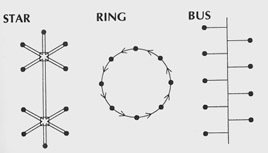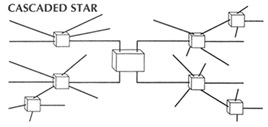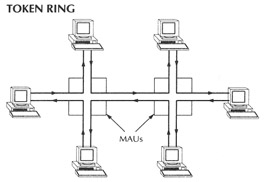Section III: Data-Link Protocols
| |
Topologies
Understanding the topology of LAN technologies can tell you a lot about your alternatives when installing or expanding a LAN. At its basic level, the topology of a network refers to the way in which all of its pieces have been connected. That is, it refers to the layout of the computers, printers, and other equipment hooked to the network in your building.
Because cable connects these scattered computing resources together into a network, your network's topology is also a function of the way in which the cabling is organized, whether it is arrayed in a bus, ring, or star, which are the three basic physical topologies available to LAN designers (see Figure 1). Although recent technological advances have blurred the distinctions between the physical and logical arrangements, the topology you select (or are forced to select) may also dictate the media-access control method (that is, Ethernet or Token Ring) under which your network will operate .

Figure 1: The three basic physical ntework topologies are the star, ring, and bus. The star is most often used in minicomputer networks. The ring was popularized by Token Ring, and the bus is used in Ethernet.
A network's logical layout may differ from its physical layout. The logical topology defines the electrical path; the physical path defines how the cables, concentrators , and nodes are arranged. For example, Ethernet must be a logical bus network; however, it can be physically configured as a bus or star. Token Ring is a logical ring, but is physically configured as a star. FDDI, a logical ring, is physically configured either as a ring or a star.
The Star Route
Until recently, the star topology has been found mostly in minicomputer and mainframe environments. These typically consist of a system of terminals or PCs, each wired to a central processor. It is also used by AT&T in both its StarLAN network and its Private Branch Exchange (PBX) based network. The star topology is ideal for wide area network (WAN) applications in which outlying offices must communicate with a central office.
A principle advantage of the star topology is that it not only allows centralizing key networking resources-concentrators or line conditioning equipment-but also gives the network administrator a focal point for network management. When something goes wrong with the network, the administrator can troubleshoot it from one place, usually a wiring closet, but possibly from a remote management console.
The star-based network requires a substantial investment in cable, however. Each workstation is connected to the central concentrator by its own dedicated line. In some star-based network technologies (ARCnet, for example) this line is coax cable that runs from an active hub to a workstation. (ARCnet can also operate as a bus.)
The 10Base-T Ethernet standard permits operating traditionally bus-based Ethernet in a star-wired configuration using unshielded twisted-pair (or high grade telephone) wiring.
Cascaded Stars
The use of a modular multiport repeater (also known as a hub or concentrator) with Ethernet allows creating large networks made of what can be called cascaded stars. In this arrangement, one centralized multiport repeater serves as the focal point for many other multiport repeaters, in effect creating a series of star-based Ethernets (see Figure 2).

Figure 2: Twisted-pair Ethernets are often composed of cascaded stars, in which multiport repeaters (represented by boxes) are connected to one another and to a central repeater.
Using modular multiport repeaters also permits mixing star- and bus-based Ethernet workgroups into a single large network. In this instance, the modular repeater must only be able to accept modules that support the many Ethernet-compatible cable types.
The Ring
IBM popularized the ring topology with its Token Ring technology. Like the bus, a Token Ring network uses a single cable. Unlike the bus, the cable's ends are looped to form a complete logical circle or ring. Physically, Token Ring is a star-wired network. Each workstation is connected directly to a central device called a Media Access Unit (MAU). Logically (or electronically ), however, the Token Ring remains a true ring (see Figure 3).

Figure 3: Although a physical star, IBM's Token Ring Implementation is logically or electronically a ring. The arrows represent a data packet as it moves from one station to another around the ring.
Unlike the bus, Token Ring uses a deterministic, rather than a contention -based, access method. In the Token Ring access method, an electronic signal called a token is passed from station to station on the ring, with each station regenerating the token as it passes by.
When a station wishes to transmit data over the network, it must wait until the token is passed to it by its neighboring station. It takes control of the station and then places a data packet on the network. Only after the data packet has made a full circuit of the ring, returning to its originator, does the station release the token for the next workstation.
Token Ring can also be expanded by linking multiple rings together, just like Ethernet. In these arrangements, one Token Ring, usually a 16Mbits/sec ring, is dedicated as an internetwork loop, with work group or departmental rings connecting to the company-wide ring via a PC running bridging software.
Taking The Bus
In a bus topology, all workstations on the network are attached to a single cable. Ethernet, AppleTalk, and IBM's PC Network are examples of bus-based networks. This sharing of the transmission media (or cable) has several important ramifications . Most importantly, it means that the cable can carry only one message at a time, and each workstation on the network must be capable of knowing when it can and cannot transmit using this shared medium.
Ethernet employs what is called a Carrier Sense Multiple Access/Collision Detection (CSMA/CD) access method to arbitrate use of the cable and to maximize its throughput. In this method, each station on the bus is always listening on the cable for transmission for other stations . It only transmits when the cable is not busy with another transmission. It is able to sense the collision that occurs when it and another station on the bus transmit at the same moment. Having sensed that a collision has occurred-and that the transmission has miscarried-each workstation waits a random time period (usually several microseconds) before retransmitting.
Naturally, frequent retransmission can slow down an Ethernet LAN; this limits the number of workstations that can be placed on any network segment. Fortunately, network managers have access to numerous devices, such as switches, bridges, and routers, that divide Ethernets in small segments to mitigate this problem.
One common arrangement is to run numerous secondary segments off a backbone bus. In a typical installation, Fast or Gigabit Ethernet segments running between a building's floors would serve as the backbone. PCs on each floor would be connected to each other and the backbone via twisted-pair cable.
These secondary or horizontal segments can be linked to the primary bus via a repeater, a bridge, or a router. Each of these devices has its own benefits and disadvantages, principally in the amount of traffic control they provide and the amount of administration they require.
Two major shortcomings of the traditional coaxial cable bus topology are that it requires lots of cable and troubleshooting the length of several thousand feet of cable can be time-consuming and frustrating. The bus topology is, however, highly expandable.
Reality Injection
Unfortunately, reality often dictates the choice of network topology and access method. For example, organizations with a large installed base of IBM equipment once generally opted for an IBM Token Ring network because IBM heavily endorsed Token Ring. Or it may be physically or financially impossible to install a particular cable type. For example, cable raceways may be jammed full with cable, dictating that you use a cable with a narrow diameter, such as fiber, or even a wireless, radio-based transmission method.
This tutorial, number 19, was originally published in the February 1990 issue of LAN Magazine/Network Magazine.
| |
EAN: 2147483647
Pages: 193